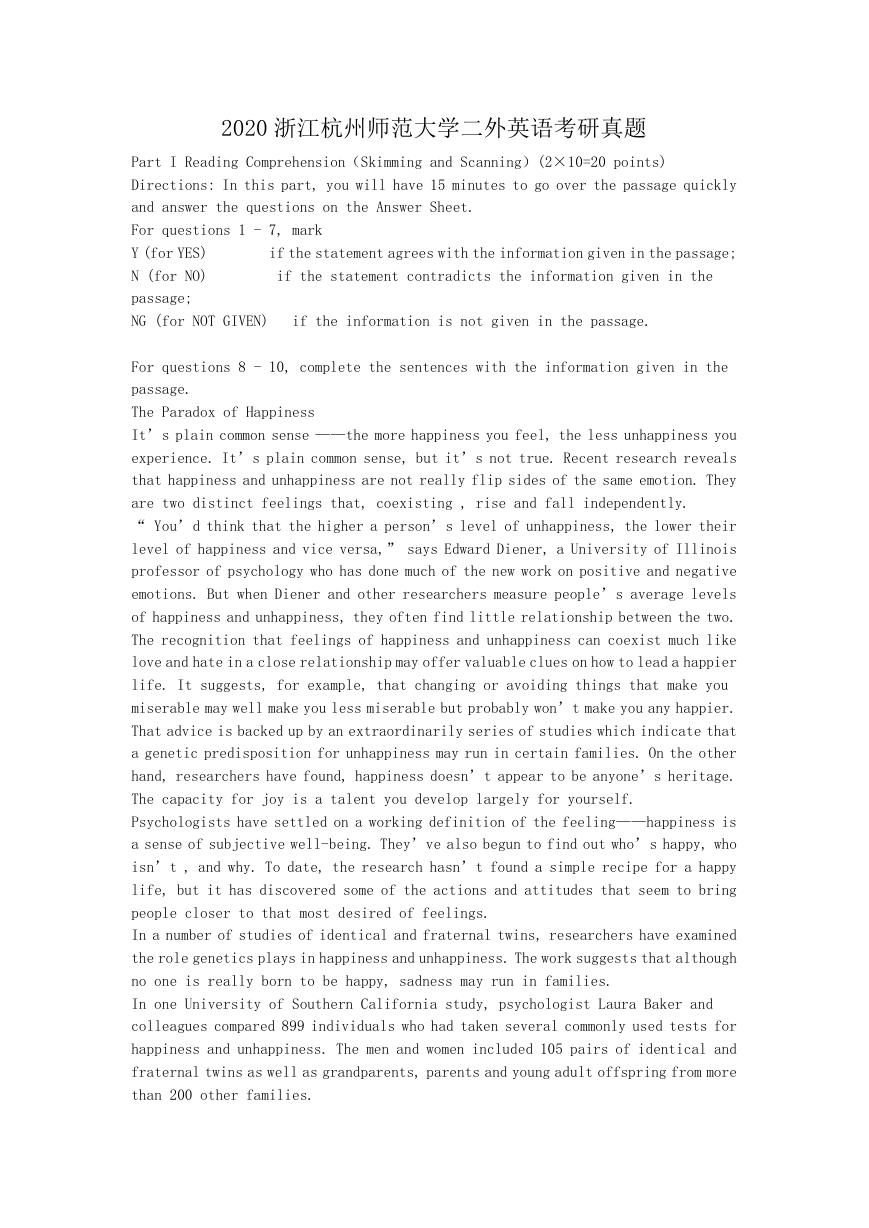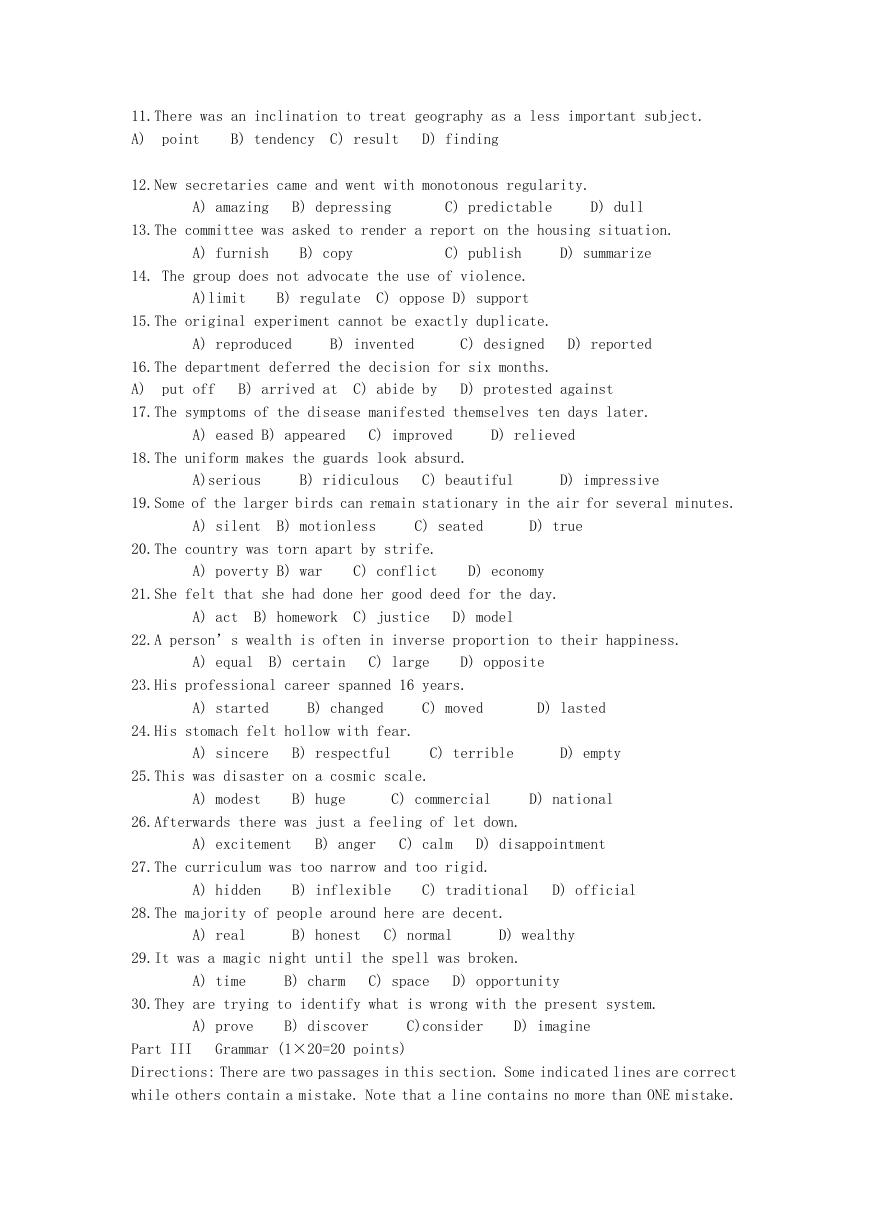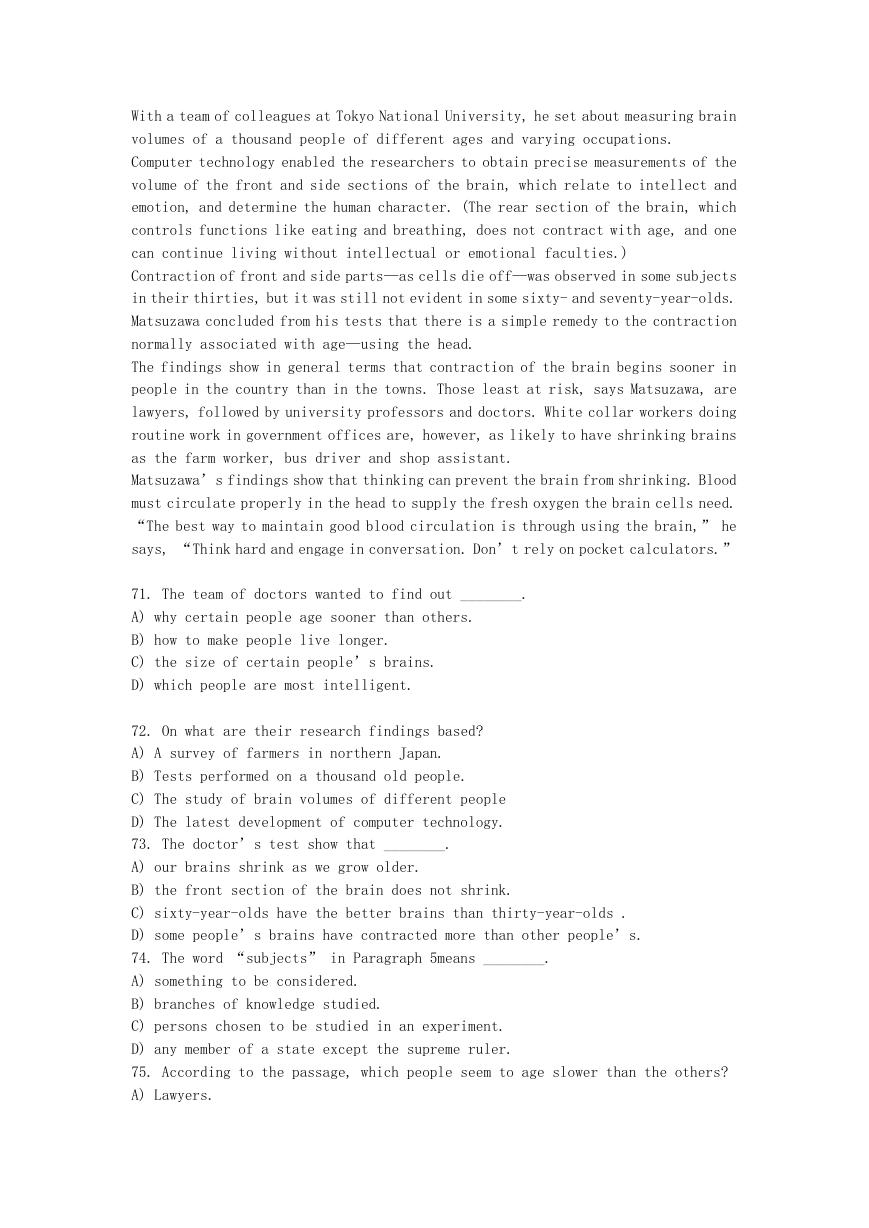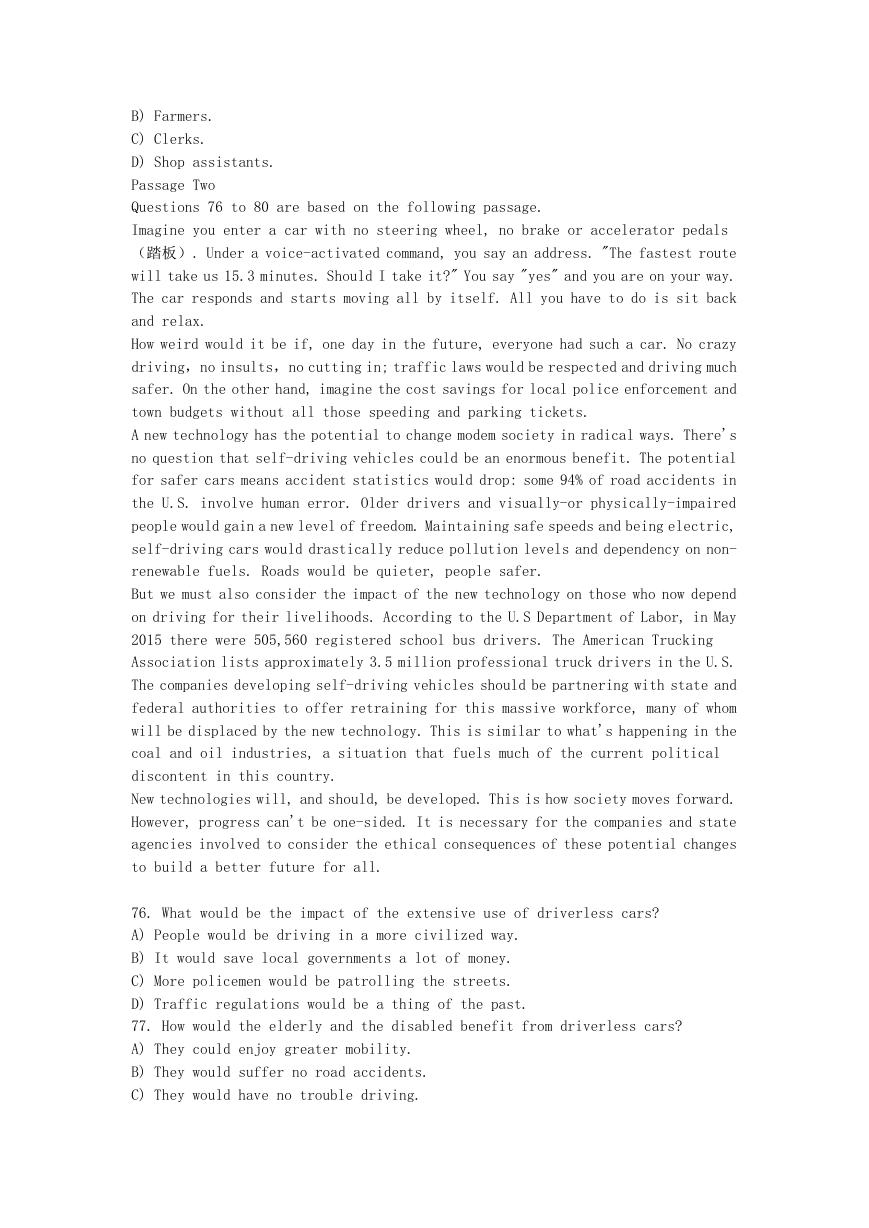2020 浙江杭州师范大学二外英语考研真题
Part I Reading Comprehension(Skimming and Scanning)(2×10=20 points)
Directions: In this part, you will have 15 minutes to go over the passage quickly
and answer the questions on the Answer Sheet.
For questions 1 - 7, mark
Y (for YES)
N (for NO)
passage;
NG (for NOT GIVEN)
if the statement agrees with the information given in the passage;
if the statement contradicts the information given in the
if the information is not given in the passage.
For questions 8 - 10, complete the sentences with the information given in the
passage.
The Paradox of Happiness
It’s plain common sense ——the more happiness you feel, the less unhappiness you
experience. It’s plain common sense, but it’s not true. Recent research reveals
that happiness and unhappiness are not really flip sides of the same emotion. They
are two distinct feelings that, coexisting , rise and fall independently.
“ You’d think that the higher a person’s level of unhappiness, the lower their
level of happiness and vice versa,” says Edward Diener, a University of Illinois
professor of psychology who has done much of the new work on positive and negative
emotions. But when Diener and other researchers measure people’s average levels
of happiness and unhappiness, they often find little relationship between the two.
The recognition that feelings of happiness and unhappiness can coexist much like
love and hate in a close relationship may offer valuable clues on how to lead a happier
life. It suggests, for example, that changing or avoiding things that make you
miserable may well make you less miserable but probably won’t make you any happier.
That advice is backed up by an extraordinarily series of studies which indicate that
a genetic predisposition for unhappiness may run in certain families. On the other
hand, researchers have found, happiness doesn’t appear to be anyone’s heritage.
The capacity for joy is a talent you develop largely for yourself.
Psychologists have settled on a working definition of the feeling——happiness is
a sense of subjective well-being. They’ve also begun to find out who’s happy, who
isn’t , and why. To date, the research hasn’t found a simple recipe for a happy
life, but it has discovered some of the actions and attitudes that seem to bring
people closer to that most desired of feelings.
In a number of studies of identical and fraternal twins, researchers have examined
the role genetics plays in happiness and unhappiness. The work suggests that although
no one is really born to be happy, sadness may run in families.
In one University of Southern California study, psychologist Laura Baker and
colleagues compared 899 individuals who had taken several commonly used tests for
happiness and unhappiness. The men and women included 105 pairs of identical and
fraternal twins as well as grandparents, parents and young adult offspring from more
than 200 other families.
�
“Family members,” Baker reports, “resembled each other more in their levels of
unhappiness than in their levels of happiness.” Furthermore, identical twins were
much closer than fraternal twins in unhappiness, a finding that implies a genetic
component.
In a study at the University of Minnesota, twins (some raised together and others
who had grown up apart) were tested for a wide range of personality traits. In terms
of happiness——defined as the capacity to enjoy life——identical twins who were
separated soon after birth were considerably less alike than twins raise together.
But when it came to unhappiness, the twins raised apart——some without contact for
as long as 64 years——were as similar as those who’d grown up together.
Why is unhappiness less influenced by environment? When we’re happy we are more
responsive to people and keep up connections better than when we’re feeling sad.
This doesn’t mean, however, that some people are born to be sad and that’s that.
Genes may predispose one to unhappiness, but disposition can be influenced by
personal choice. You can increase your happiness through your own actions.
In a series of experiments by psychologists John Reich and Alex Zautra at Arizona
State University, they asked students to select their favorite activities from a
list of everyday pleasures——things like going to a movie, talking with friends
and playing cards.
Then the researchers instructed some of the subjects to increase the number of
favorite activities they participated in for one month (the other participants in
the study served as controls and did not vary their activity level). Results: Those
who did more of the things they enjoyed were happier than those who didn’t. The
conclusion, then, is that the pleasure we get from life is largely ours to control.
The feeling of unhappiness may be genetic.
There is a strong relationship between levels of happiness and unhappiness in
Researchers have found that happiness is inherited.
Unhappiness is less influenced by environment than it is by genetics.
It is impossible to increase your happiness.
We can control our own happiness.
The level of happiness may vary with gender.
Family members resembled each other more in their levels of unhappiness than
1.
2.
a person.
3.
4.
5.
6.
7.
8.
in ____________.
9.
California.
10. Studiessuggest that in order to be happier, we need to increase the number of
_______________.
Part II
Directions:Choose the best answer you think most suitable to explain the underlined
words or phrases in each sentence . Please write down the corresponding letter on
the Answer Sheet.
_______people took part in the study conducted by University of Southern
Vocabulary
(0.5×20=10 points)
�
11.There was an inclination to treat geography as a less important subject.
A)
B) tendency C) result
D) finding
point
12.New secretaries came and went with monotonous regularity.
A) amazing
B) depressing
C) predictable
D) dull
13.The committee was asked to render a report on the housing situation.
A) furnish
C) publish
14. The group does not advocate the use of violence.
C) oppose D) support
B) regulate
A)limit
B) copy
D) summarize
15.The original experiment cannot be exactly duplicate.
A) reproduced
B) invented
C) designed
D) reported
16.The department deferred the decision for six months.
A)
17.The symptoms of the disease manifested themselves ten days later.
D) protested against
B) arrived at
C) abide by
put off
A) eased B) appeared
C) improved
D) relieved
18.The uniform makes the guards look absurd.
A)serious
B) ridiculous
C) beautiful
D) impressive
19.Some of the larger birds can remain stationary in the air for several minutes.
A) silent
B) motionless
C) seated
D) true
20.The country was torn apart by strife.
C) conflict
A) poverty B) war
D) economy
21.She felt that she had done her good deed for the day.
A) act
B) homework
C) justice
D) model
22.A person’s wealth is often in inverse proportion to their happiness.
A) equal
B) certain
C) large
D) opposite
23.His professional career spanned 16 years.
A) started
B) changed
C) moved
D) lasted
24.His stomach felt hollow with fear.
A) sincere
B) respectful
C) terrible
D) empty
25.This was disaster on a cosmic scale.
A) modest
B) huge
C) commercial
D) national
26.Afterwards there was just a feeling of let down.
A) excitement
B) anger
C) calm
D) disappointment
27.The curriculum was too narrow and too rigid.
A) hidden
B) inflexible
C) traditional
D) official
28.The majority of people around here are decent.
A) real
B) honest
C) normal
D) wealthy
29.It was a magic night until the spell was broken.
A) time
B) charm
C) space
D) opportunity
30.They are trying to identify what is wrong with the present system.
A) prove
B) discover
C)consider
D) imagine
Grammar (1×20=20 points)
Part III
Directions: There are two passages in this section. Some indicated lines are correct
while others contain a mistake. Note that a line contains no more than ONE mistake.
�
underline the wrong word and write the correct one in the blank
For the correct lines, put a tick (√) on the blanks while for the wrong ones, you
should correct it in the following way:
For a wrong word,
provided at the end of the line.
For a missing word, mark the position of the missing word with a “^” sign and write
the word you believe to be missing in the blank provided at the end of the lien.
Example
When ^ art museum wants a new exhibit,
it buys things in finished form and hangs
them on the wall. When a natural history museum
wants an exhibition, it must often build it.
(3) exhibit
(1)
an
(2) √
A.
What fun it is to jump into a pool or go swimming in a river in summer! What joyful
and relaxing it is to have a game of table tennis after a day of study at school!
And how exciting it is to play and watch a close game of basketball or volleyball!
All over the world millions of people take part different kinds of sports. Sports
are perhaps the more popular form of relaxation that almost all can enjoy, no matter
what they are, boys or girls, men or women, young or old.
Some people seem to think that sports and games are unimportant things that people
do at times when they are not working, instead
going to the cinema, listening the
radio, or sleeping. But in fact, sports and games can be of great value, especially
to people work with their brains. They should not be treated only as amusement.
31. _______________
32. _______________
33. _______________
34. _______________
35. _______________
36. _______________
37. _______________
38. _______________
39. _______________
40. _______________
B.
People in countries as far apart as Japan, the United States, Australia and France
sends Valentine cards to someone they fancy in 14 February, St. Valentine’s Day.
Most cards are romantic but express secret love messages which don’t let on who
the sender is.
Senders of newspaper messages, no matter which they are in Britain, North America
or Australia, must get a thrill out of their exhibitionism without letting who is
the secret admirer hidden in the words of the advertise. The British newspaper ad
brigades tend to see themselves or the desired ones for animals, with bears being
�
the firm favorites. But fleas, toads, bugs and mice are well represented.
In parts of the English countryside it is still believe that a girl can tell the
occupation of her future husband by noting which bird she sees first on 14 February.
But if it’s a woodpecker, she will find no man at all. Happy bird-watching! Happy
Valentine’s Day!
41. _______________
42. _______________
43. _______________
44. _______________
45. _______________
46. _______________
47. _______________
48. _______________
49. _______________
50. _______________
Part IV Cloze (0.5×20=10 points)
Directions:There are 20 blanks in the following passage. For each blank there are
four choices marked A, B, C and D. You should choose the ONE that best fits into
the passage. Then write down the corresponding letter on the Answer Sheet.
For many years, we have been led to believe that a person’s intellectual
intelligence is the greatest predictor of success. Society (51) _____ that people
with high IQ will naturally accomplish(52) _____ in life. Schools often use IQ test
results to (53) _____ children for gifted programs and advanced (54) _____. Some
companies even use the results (55) _____ a criterion for hiring employees.
In the past 10 years, we have been conditioned to (56) _____ intelligence with these
numbers. (57) _____, researchers have found that this isn’t necessarily the case.
They have discovered that more than IQ, your (58) _____ awareness and abilities to
handle feelings will determine your success in all (59) _____ of life, (60) _____
family relationships.
In the early 1990s, Dr. John Mayer and Dr. Peter Salovey (61) _____ the term
“emotional intelligence” in the Journal of Personality Assessment. They used this
(62) _____ to describe people’s ability to understand their own emotions and
emotions of others and to act (63) _____ based on this understanding. Then in 1995,
psychologist Daniel Goleman (64) _____ this term with his book Emotional
Intelligence: Why It Can Matter More Than IQ.
(65) _____ investigated emotional intelligence by measuring related concepts, (66)
_____ social skills, interpersonal competence, psychological (67) _____, long
before the term “emotional intelligence” came into (68) _____. Social scientists
are just beginning to (69) _____ the relationship of EQ to other phenomenon. (70)
_____ Goleman, “Emotional intelligence, the skills that help people harmonize,
should become increasingly valued as a workplace asset in the years to come.”
51. A. assumes
B. believes
C. thinks
D. holds
�
B. more
C. with
D. Moreover
D. idiom
D.
D.
D.
D.
D.
C. emotional
B. tests
C. courses
B. levels
C. points
B. name
C. phrase
B. make
C. allow
C. many
D. less
B. made
C. called
B. correctly
C. properly
B. involving
C. consisting
C. say
C. Yet
B. created
C. publicized
D.
D.
D.
D.
D. by
D.
B. for
B. judge
B. However
B. intellectual
52. A. some
53. A. choose
distinguish
54. A. levels
works
55. A. as
56. A. know
determine
57. A. Certainly
58. A. mental
affectional
59. A. fields
walks
60. A. including
taking
61. A. named
introduced
62. A. term
63. A. perfectly
precisely
64. A. invented
popularized
65. A. Teachers
66. A. for example
67. A. maturity
mellowness
68. A. effect
power
69. A. uncover
70. A. As for
regards
Part V Reading Comprehension (Reading in Depth)(1.5×20=30 points)
Directions: There are 3 passages in this section. Each passage is followed by some
questions or unfinished statements. For each of them there are four choices marked
A), B), C) and D). You should decide on the best choice and write down the
corresponding letter on the Answer Sheet.
Passage One
Questions 71 to 75 are based on the following passage.
If you want to stay young, sit down and have a good think. This is the research finding
of a team of Japanese doctors, who say that most of our brains are not getting enough
exercise—and as a result, we are ageing unnecessarily soon.
Professor Taiju Matsuzawa wanted to find out why otherwise healthy farmers in
northern Japan appeared to be losing their ability to think and reason at a relatively
early age, and how the process of ageing could be slowed down.
B. Doctors
B. for instance
B. ripeness
C. Researchers
C. such as
C. familiarity
D. Workers
D. about
D.
B. unsettle
B. As to
C. According to
D. As
B. operation
C. use
C. unlock
D. undress
�
With a team of colleagues at Tokyo National University, he set about measuring brain
volumes of a thousand people of different ages and varying occupations.
Computer technology enabled the researchers to obtain precise measurements of the
volume of the front and side sections of the brain, which relate to intellect and
emotion, and determine the human character. (The rear section of the brain, which
controls functions like eating and breathing, does not contract with age, and one
can continue living without intellectual or emotional faculties.)
Contraction of front and side parts—as cells die off—was observed in some subjects
in their thirties, but it was still not evident in some sixty- and seventy-year-olds.
Matsuzawa concluded from his tests that there is a simple remedy to the contraction
normally associated with age—using the head.
The findings show in general terms that contraction of the brain begins sooner in
people in the country than in the towns. Those least at risk, says Matsuzawa, are
lawyers, followed by university professors and doctors. White collar workers doing
routine work in government offices are, however, as likely to have shrinking brains
as the farm worker, bus driver and shop assistant.
Matsuzawa’s findings show that thinking can prevent the brain from shrinking. Blood
must circulate properly in the head to supply the fresh oxygen the brain cells need.
“The best way to maintain good blood circulation is through using the brain,” he
says, “Think hard and engage in conversation. Don’t rely on pocket calculators.”
71. The team of doctors wanted to find out ________.
A) why certain people age sooner than others.
B) how to make people live longer.
C) the size of certain people’s brains.
D) which people are most intelligent.
72. On what are their research findings based?
A) A survey of farmers in northern Japan.
B) Tests performed on a thousand old people.
C) The study of brain volumes of different people
D) The latest development of computer technology.
73. The doctor’s test show that ________.
A) our brains shrink as we grow older.
B) the front section of the brain does not shrink.
C) sixty-year-olds have the better brains than thirty-year-olds .
D) some people’s brains have contracted more than other people’s.
74. The word “subjects” in Paragraph 5means ________.
A) something to be considered.
B) branches of knowledge studied.
C) persons chosen to be studied in an experiment.
D) any member of a state except the supreme ruler.
75. According to the passage, which people seem to age slower than the others?
A) Lawyers.
�
B) Farmers.
C) Clerks.
D) Shop assistants.
Passage Two
Questions 76 to 80 are based on the following passage.
Imagine you enter a car with no steering wheel, no brake or accelerator pedals
(踏板). Under a voice-activated command, you say an address. "The fastest route
will take us 15.3 minutes. Should I take it?" You say "yes" and you are on your way.
The car responds and starts moving all by itself. All you have to do is sit back
and relax.
How weird would it be if, one day in the future, everyone had such a car. No crazy
driving,no insults,no cutting in; traffic laws would be respected and driving much
safer. On the other hand, imagine the cost savings for local police enforcement and
town budgets without all those speeding and parking tickets.
A new technology has the potential to change modem society in radical ways. There's
no question that self-driving vehicles could be an enormous benefit. The potential
for safer cars means accident statistics would drop: some 94% of road accidents in
the U.S. involve human error. Older drivers and visually-or physically-impaired
people would gain a new level of freedom. Maintaining safe speeds and being electric,
self-driving cars would drastically reduce pollution levels and dependency on non-
renewable fuels. Roads would be quieter, people safer.
But we must also consider the impact of the new technology on those who now depend
on driving for their livelihoods. According to the U.S Department of Labor, in May
2015 there were 505,560 registered school bus drivers. The American Trucking
Association lists approximately 3.5 million professional truck drivers in the U.S.
The companies developing self-driving vehicles should be partnering with state and
federal authorities to offer retraining for this massive workforce, many of whom
will be displaced by the new technology. This is similar to what's happening in the
coal and oil industries, a situation that fuels much of the current political
discontent in this country.
New technologies will, and should, be developed. This is how society moves forward.
However, progress can't be one-sided. It is necessary for the companies and state
agencies involved to consider the ethical consequences of these potential changes
to build a better future for all.
76. What would be the impact of the extensive use of driverless cars?
A) People would be driving in a more civilized way.
B) It would save local governments a lot of money.
C) More policemen would be patrolling the streets.
D) Traffic regulations would be a thing of the past.
77. How would the elderly and the disabled benefit from driverless cars?
A) They could enjoy greater mobility.
B) They would suffer no road accidents.
C) They would have no trouble driving.
�
















 2023年江西萍乡中考道德与法治真题及答案.doc
2023年江西萍乡中考道德与法治真题及答案.doc 2012年重庆南川中考生物真题及答案.doc
2012年重庆南川中考生物真题及答案.doc 2013年江西师范大学地理学综合及文艺理论基础考研真题.doc
2013年江西师范大学地理学综合及文艺理论基础考研真题.doc 2020年四川甘孜小升初语文真题及答案I卷.doc
2020年四川甘孜小升初语文真题及答案I卷.doc 2020年注册岩土工程师专业基础考试真题及答案.doc
2020年注册岩土工程师专业基础考试真题及答案.doc 2023-2024学年福建省厦门市九年级上学期数学月考试题及答案.doc
2023-2024学年福建省厦门市九年级上学期数学月考试题及答案.doc 2021-2022学年辽宁省沈阳市大东区九年级上学期语文期末试题及答案.doc
2021-2022学年辽宁省沈阳市大东区九年级上学期语文期末试题及答案.doc 2022-2023学年北京东城区初三第一学期物理期末试卷及答案.doc
2022-2023学年北京东城区初三第一学期物理期末试卷及答案.doc 2018上半年江西教师资格初中地理学科知识与教学能力真题及答案.doc
2018上半年江西教师资格初中地理学科知识与教学能力真题及答案.doc 2012年河北国家公务员申论考试真题及答案-省级.doc
2012年河北国家公务员申论考试真题及答案-省级.doc 2020-2021学年江苏省扬州市江都区邵樊片九年级上学期数学第一次质量检测试题及答案.doc
2020-2021学年江苏省扬州市江都区邵樊片九年级上学期数学第一次质量检测试题及答案.doc 2022下半年黑龙江教师资格证中学综合素质真题及答案.doc
2022下半年黑龙江教师资格证中学综合素质真题及答案.doc